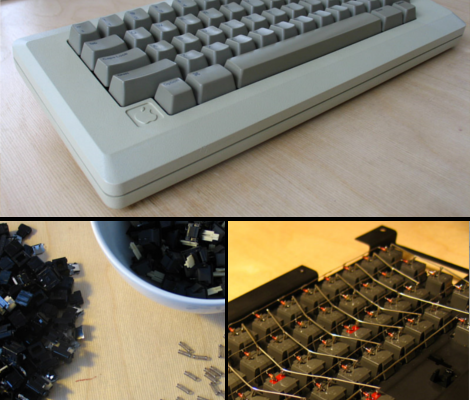
Deskthority forum user [lowpoly] recently posted a writeup on his complete overhaul of an Apple M0110 mechanical keyboard. Any one familiar with the satisfying clack of a good mechanical key under their fingers can appreciate the effort put into this project.
[lowpoly] removed the keyboard’s PCB, rewired the key matrix adding diodes, built in a teensy USB board, broke apart the mechanical switches and fit replacement springs and finally applied a generous portion of retr0bright to all of the aging plastic. Since the teensy has no mounting holes [lowpoly] had to create a mounting assembly out of some spare plastic. A usb mini cable is even fitted into the original RJ-11 connector. To compensate for the lack of PCB the key assembly was fitting with some rubber washers. To top off the whole thing some nice new rubber feet were taped to the underside of the M0110.
[lowpoly] reports that with the foam, new springs, and lack of PCB the keyboard is much quieter and easy to use. The end result is a slick retro looking modern keyboard. If you’ll excuse us we have to go rooting through some old storage bins to find our own ancient keyboards.
We have seen our share of vintage keyboard hacks which can be useful, impressive and sometimes just odd. This build keeps it down to a nice simple, functional, useful retrofit. Nice work!
















Only IBM, Lexmark, and Unicomp ever made buckling spring keyboards. These are purely mechanical.
Yikes, you are correct! Fixed!
Would have been nice if he had the matching number pad and mouse!
maybe it`s just me, there seems to be a resurgence of Retro type/style hacks and equipment used lately.
this can in my opinion only be a Good thing.
It`s certainly a pleasure to see and read about these “old school” bits of kit finding a new life again!
this totally gets a +1 from me ;)
If it still works, why not still use it?
i like the teletype SMS myself.
>.> wonder if a teletype would make a nice keyboard…
I thought the point was to have a keyboard with a loud *CLACK*
I prefer a nice soothing *CLACK*.
i’ve got an old tandy laptop i’ve been meaning to do this with for a while… haven’t gotten around to it. this will be a handy readup.
If it’s a Tandy 102 you could use it to pass input to a terminal session on a computer. Not the perfect solution, but not bad.
Another option I used to get the old keyboard working off my CNC lathe is use a Pokeys board. It gives you 55 IO and direct connections to USB. It will handle up to a 8×16 keyboard array. More expensive than a teensy but much simpler and easier. The GUI setup program makes programming the keyboard layout quick and easy.
http://www.poscope.com/product.php?pid=2
I have a couple model M keyboards from IBM. They are definitely mechanical and have the wonderful feedback that I want from a keyboard.
Nice work on the restore and thanks for reminding me about retr0brite, that is good stuff!
I got a dasKeyboard for christmas.. best christmas ever!!
before that, I had an old mechanical keyboard that felt and sounded just like the dasKeyboard, with the BTC logo on a the lable on the underside. it was an AT keyboard, I think with a switch for XT. so I used an AT to PS/2 connector, and connected that to a PS/2 to USB adapter.. and it would work, kinda.
every so many key strokes, it would double. sso I woulld typpe noormallly and it wwould end up loooking someething likee this. does anybody know what’s going on with that? I would really like to use that keyboard again on another machine because it has a solid flip up/down cover and is actually retro instead of the pseudo-retro that the dasKeyboard provides. oh, and the bottom was also a powder coated metal plate instead of being all plastic.
that keyboard probably has a “bouncing” signal. if that’s the case, i’m not sure how you’d fix it, i remember something about how to fix it, but I dont want to steer you off. look up keyboard debounce circuit, you might pick up what you need
To fix this you would neet a non-inverting schmitt trigger (or two inverting schmitt triggers in series…) All of the best input devices use these for a true hardware “debounce” most USB encoders use software debounce.
Beautiful, neat work.